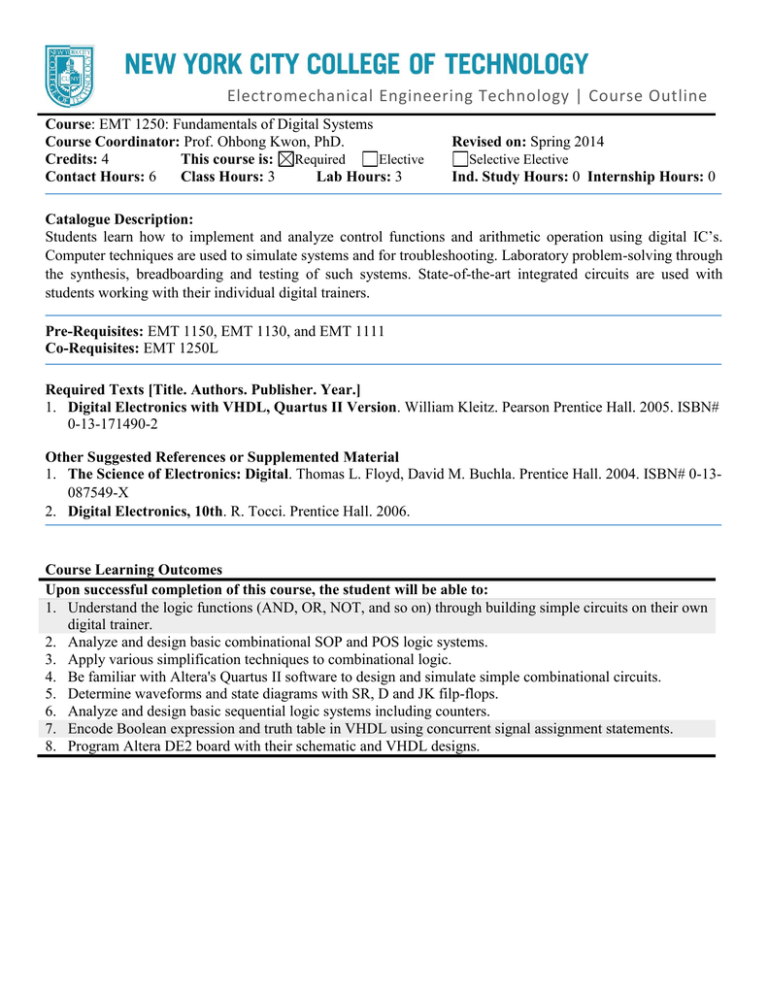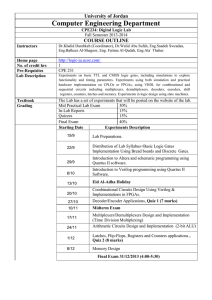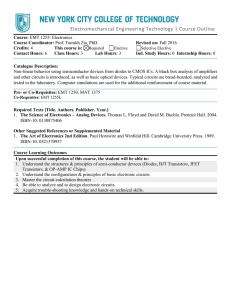
Electromechanical Engineering Technology | Course Outline
Course: EMT 1250: Fundamentals of Digital Systems
Course Coordinator: Prof. Ohbong Kwon, PhD.
Credits: 4
This course is: Required
Elective
Contact Hours: 6
Class Hours: 3
Lab Hours: 3
Revised on: Spring 2014
Selective Elective
Ind. Study Hours: 0 Internship Hours: 0
Catalogue Description:
Students learn how to implement and analyze control functions and arithmetic operation using digital IC’s.
Computer techniques are used to simulate systems and for troubleshooting. Laboratory problem-solving through
the synthesis, breadboarding and testing of such systems. State-of-the-art integrated circuits are used with
students working with their individual digital trainers.
Pre-Requisites: EMT 1150, EMT 1130, and EMT 1111
Co-Requisites: EMT 1250L
Required Texts [Title. Authors. Publisher. Year.]
1. Digital Electronics with VHDL, Quartus II Version. William Kleitz. Pearson Prentice Hall. 2005. ISBN#
0-13-171490-2
Other Suggested References or Supplemented Material
1. The Science of Electronics: Digital. Thomas L. Floyd, David M. Buchla. Prentice Hall. 2004. ISBN# 0-13087549-X
2. Digital Electronics, 10th. R. Tocci. Prentice Hall. 2006.
Course Learning Outcomes
Upon successful completion of this course, the student will be able to:
1. Understand the logic functions (AND, OR, NOT, and so on) through building simple circuits on their own
digital trainer.
2. Analyze and design basic combinational SOP and POS logic systems.
3. Apply various simplification techniques to combinational logic.
4. Be familiar with Altera's Quartus II software to design and simulate simple combinational circuits.
5. Determine waveforms and state diagrams with SR, D and JK filp-flops.
6. Analyze and design basic sequential logic systems including counters.
7. Encode Boolean expression and truth table in VHDL using concurrent signal assignment statements.
8. Program Altera DE2 board with their schematic and VHDL designs.
Student Outcomes listed in the ETAC/ABET Criterion 3 Addressed in this Course
Student Outcomes
a. An ability to apply the knowledge, techniques, skills, and modern tools of the discipline to
narrowly defined engineering technology activities;
b. An ability to apply a knowledge of mathematics, science, engineering, and technology to
engineering technology problems that require limited application of principles but extensive
practical knowledge;
c. An ability to conduct standard tests and measurements, and to conduct, analyze, and interpret
experiments;
d. An ability to function effectively as a member of a technical team;
e. An ability to identify, analyze, and solve narrowly defined engineering technology problems;
f. An ability to apply written, oral, and graphical communication in both technical and non-technical
environments; and an ability to identify and use appropriate technical literature;
g. An understanding of the need for and an ability to engage in self-directed continuing professional
development;
h. An understanding of and a commitment to address professional and ethical responsibilities,
including a respect for diversity;
i. A commitment to quality, timeliness, and continuous improvement;
j. Use computer-aided drafting or design tools to prepare graphical representations of
electromechanical systems.
k. Use circuit analysis, analog and digital electronics, basic instrumentation, and computers to aid in
the characterization, analysis, and troubleshooting of electromechanical systems.
l. Use statics, dynamics (or applied mechanics), strength of materials, engineering materials,
engineering standards, and manufacturing processes to aid in the characterization, analysis, and
troubleshooting of electromechanical systems.
Level
R
R
R
R
R
R
R
R
R
Legend: I (Introduce), R (Reinforce) and E (Emphasize).Unmarked means not addressed.
Brief list of topics to be covered
Introduction and motivation and Number Systems and Codes
Week 1
Digital Electronic Signals and Switches
Week 2
Basic Logic Gates
Week 3
Basic Logic Gates
Week 4
Boolean Algebra and Reduction Techniques
Week 5
Boolean Algebra and Reduction Techniques
Week 6
Exclusive-Or and Exclusive-Nor Gates
Week 7
Midterm Exam
Week 8
Arithmetic Operations and Circuits
Week 9
Week 10
Week 11
Week 12
Week 13
Week 14
Week 15
Code Converters, Multiplexers, and Demultiplexers
Flip-Flops and Registers
Flip-Flops and Registers
Counter Circuits and VHDL State Machines
Shift Registers
Final Exam





